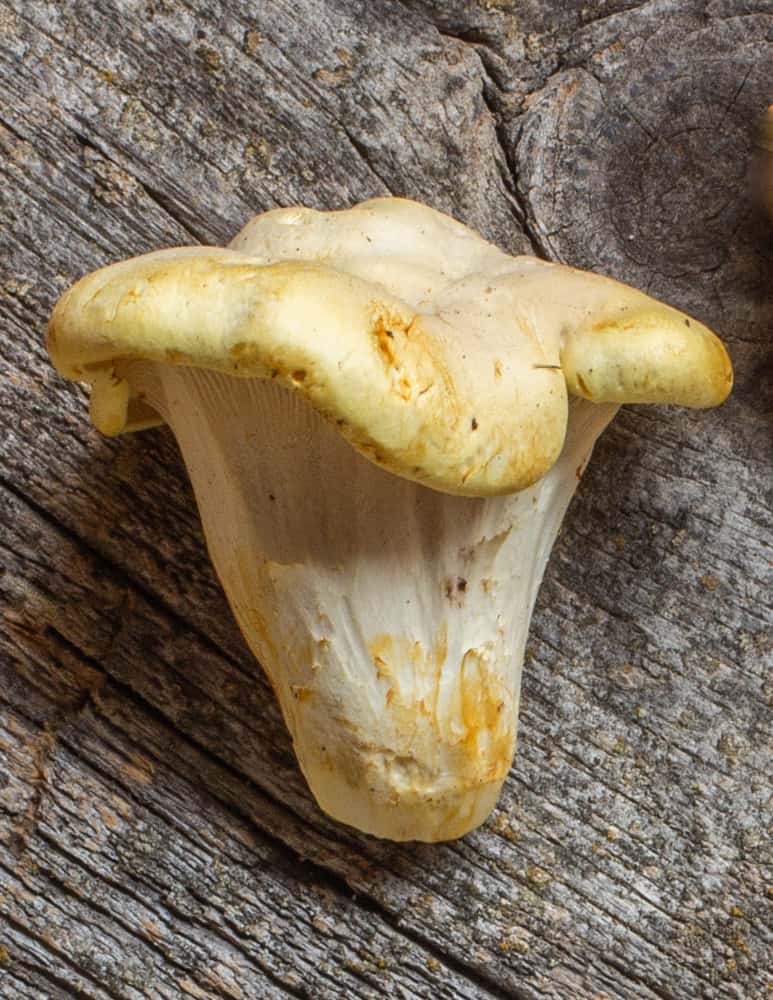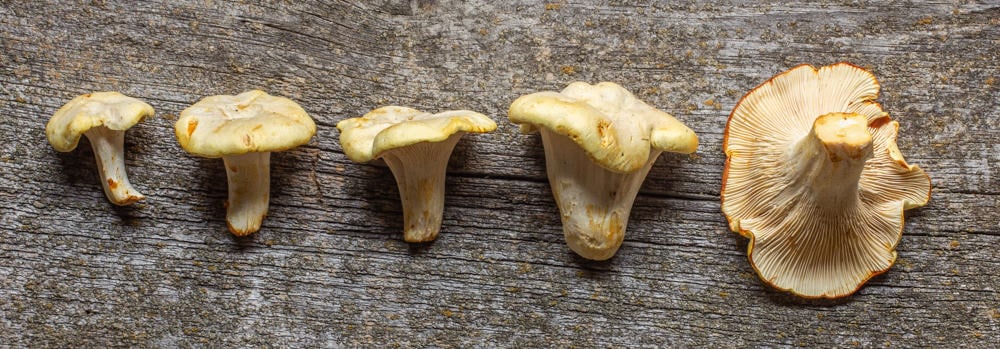Seven years ago I picked my first white chanterelle. Now, just this week, they were finally published in an academic study.
Disclaimer
This post has no relation to penis envy (Psilocybe cubensis) or any psychedelic (magic) mushrooms.

Look up white chanterelles up in a guide book, and you'll see pictures of Cantharellus subaldibus. You'll also see in guide books that white chanterelles do not grow in the Midwest.

Mushroom species haven't been studied as intensely as other things, we're now learning more and more about fungi, their ecological importance, and, the most exciting for mushroom hunters: dissemination and differentiation between species using genetic sequencing.

I was really excited that the white chanterelles I harvested could be an undescribed species: a holy grail of mushroom hunters. So, I wrote a post on white chanterelles years ago.

Year after year, I kept finding my white chanterelles in the same patch near other golden chanterelles (a patch of C. phasmatis, a species described by Tom Volk, along with a few others in his study in 2013).
Then, few years ago, I got a message from author and mycologist Andrus Voitk, a chanterelle specialist who, along with Professor Greg Thorn, named Cantharellus enelensis back in 2017.

Andrus informed me he was working to sequence the albino mushrooms, and asked if I would send in some dried specimens.
I mailed samples and waited. Eventually Andrus sent me his findings, three years later.

Many mushrooms have an albino mutation
Here's the cliff notes on their results. Essentially the white chanterelles I pick are not a new species. They're a sort of atypical, albino mutation of C. phasmatis.
To make it more interesting, the phenomena happens not only to C. phasmatis, but other species of chanterelles as well (see the image of C. enelensis alongside their normal coloration.)
White black trumpet mushrooms are also possible. I have two friends that pick them in California.

Do they taste different?
Yes, albino mushrooms taste different than the normal ones. Andrus and I discussed eating and flavor. Both of us agree the albino versions taste different.
The chanterelle aroma and flavor is there, but it is more subtle, they are only lightly perfumed, and have a more delicate, savory quality to them.
In the article, the difference in taste is postulated to be from specific terpenes (compounds responsible for how many plants smell) that the albino mushrooms lack.

Similarly, I taste the same difference and muted flavor when I eat white lobster mushrooms (much more common in my experience than white chanterelles) alongside regular lobster mushrooms.
This is a small detail and the average person will be unable to notice the difference in the mushrooms unless tasted side by side. Even then, they would need to be familiar with the flavors of the Cantharellacae.

You can be a citizen scientist, too
The case on the white albino chants is closed, but there are undoubtedly other fungal puzzles out there to unlock. The real takeaway here, as I see it, is a comment on the state of fungal research and the increasing importance of citizen science.
Amateur mushroom hunters have long been one of the driving forces behind mycology, and normal people like you and me, without phd's, can help contribute to our expanding knowledge of the natural world, just by looking down at the ground with our hungry forager's eyes, primed to notice things that seem out of the ordinary.
Slow down outside, and stop to smell the mushrooms. You never know what you might find.

Laura
Picking White Chanterelles South of Nanaimo BC Canada. Plenty of them.
Dana Lasswell
Our experience is exactly the same and we agree what we are finding is not an albino chanterelle. And soooo delish! Thanks for your reply post. Mush love!
Alan Bergo
Thanks Dana
JC
Thanks for sharing this research!
At least in the northern PNW Cascades and westward, C. subalbidus mentioned by Debbie above is distinctly different than the regionally dominant golden species C. formosus, as well as most of the photos from your post, which do look like albino versions of "regular" chanterelles.
Here, in my experience C. subalbidus has significantly thicker stalks and is overall much meatier than C. formosus, frequently clublike and partially submerged in duff as opposed to slender-stemmed goldens poking out of moss patches. I find them rarely on the west/wet side, but they are locally abundant on the dry side of the Cascade crest at elevation. I have also found C. cascadensis growing alongside them with nearly identical morphology aside from the cap being yellow with the gills and interior white (aka "hybrid" chanterelles.) The habitat and climate is distinctly different than where C. formosus is abundant, much drier and with a different mix of conifers.
Also in contrast to the NL examples and your description, the aroma and flavor is superior to C. formosus, as is the texture, which is silkier. (Of course these are value judgments and some may disagree.) In any case they do not seem to be an albino variant of one of the locally common Cantharellus species as with the white NL specimens.
Alan Bergo
Thanks JC, have to agree with you there on formosus. I've eaten many chants, and it's on the bottom of my list. I've never picked them though, so hopefully I see them soon as I'm in B.C. filming a new show for 2 weeks.
Paula cannon
I was wondering about this. I live in extreme northeast Georgia and I have a small area on my mountain property that I find white Chanterelles every year. They grow in a line about 6 feet long, right near golden ones. I too was hoping they were a different species, now I know.
Off the subject…I love October for Gypsy and oyster mushrooms. This has been a wonderful oyster mushroom year here, they’re huge! Have you ever tossed them in egg and olive oil and dusted them with breadcrumbs and put them on parchment lined sheet pans, bake till brown and make oyster Parmesan with them? So good. Excellent right out of the oven too, they’re addictive! Happy cooking, we love you
Debbie Viess
Isn't it fun to have actually tracked this down? Our western C. subalbidus IS white, but also can show some yellowing.
Color is variable in most fungi, as well as in animals. We sometimes find yellow versions of the black chanterelle, Craterellus calicornucopioides, and I have even found pink Craterellus tubaeformis!
https://mushroomobserver.org/image/show_image/598064?obs=231085&q=1kLFl
https://mushroomobserver.org/image/show_image/10662?obs=6212&q=1kLFS
My group of interest is really amanitas, and I have found white forms of many different colored species, Color can be more variable in fungi than we might think!
Keep on finding cool fungi and keep on asking questions!
Joanne Burnett
Thanks to your blog I have learned to identify several varieties of edible mushrooms that grow my neighb8ors yards. AND your recipes make it easy to try a new variety. I inherited my dad's mushroom books. He always commented that the photos weren't that good. Your photos are wonderful.
Brian Bradley
Very cool!
Jean yarbrough
That should have read mid coast Maine. Autocorrect Doty make morons of us all.
Jean yarbrough
This is fascinating. I stumbled across albino chanterelles while foraging in mid last Maine. I was curious about them, but was too curious to eat them. Next summer I’ll be on the lookout and report back.
Alan Bergo
Thanks Jean, always good to keep your eyes open.
Dan F
Fascinating!